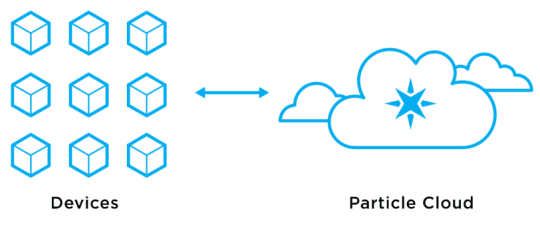Because that's what makes it an IoT project: interacting with devices all over the place.
This is when it gets interesting: when you set something in motion and things happen remotely, distantly. Or, moving the other way, you pull data from far-flung sensors.
That's where the cloud comes in. It's kind of a relay: you send your instructions there, and then bounce them out to your devices: making them do something, or deliver information back to you. It's like have a widely-distributed info army at your command.
In the Particle literature they often talk about "managing your fleet of devices."
And that turns out to be the major, worthwhile thing you can do with a Particle Photon.
Here are the deets, from the Particle site:
- Set up the pins on the Particle as outputs that have LEDs connected to them
- Create and register a Particle function that gets called automagically when you make a request to it. This is often referred to as an API request.
- Parse the incoming command and take appropriate actions, ie: blink that LED!
Later in that same short document, you get the concept (and the code) behind reading info from (as opposed to sending information to) a photoresister, or a motion detector on one side of the earth, and publishing the data from it to the other side of the planet.
Basic IoT stuff.
This kind of radical info distribution can be a difficult concept to convey at a regular Tuesday night Cambridge Hackspace Open Project Night. You are struggling to get your phone to send instructions to a website that's hosted thousands of miles away, then use some Javascript on that website to send instructions to the cloud, located in a server farm another few thousand miles away, and then -- via a third thousand-mile trip -- light up the LED that's sitting two feet away from you, next to a bag of chips, a bottle of beer, and a tiny, mortally wounded drone.
It doesn't look too impressive: that blinking light. Which is why you often hear yourself saying, "Imagine this light is far away, like in Berlin."
Most people get it, you think.
Once a project emerges from the Hackspace into an actual public place, it will get realer. Because there's no way that you can be sitting next to it, explaining and hand waving.
It just has to work -- and be fun, or informative, or helpful.
